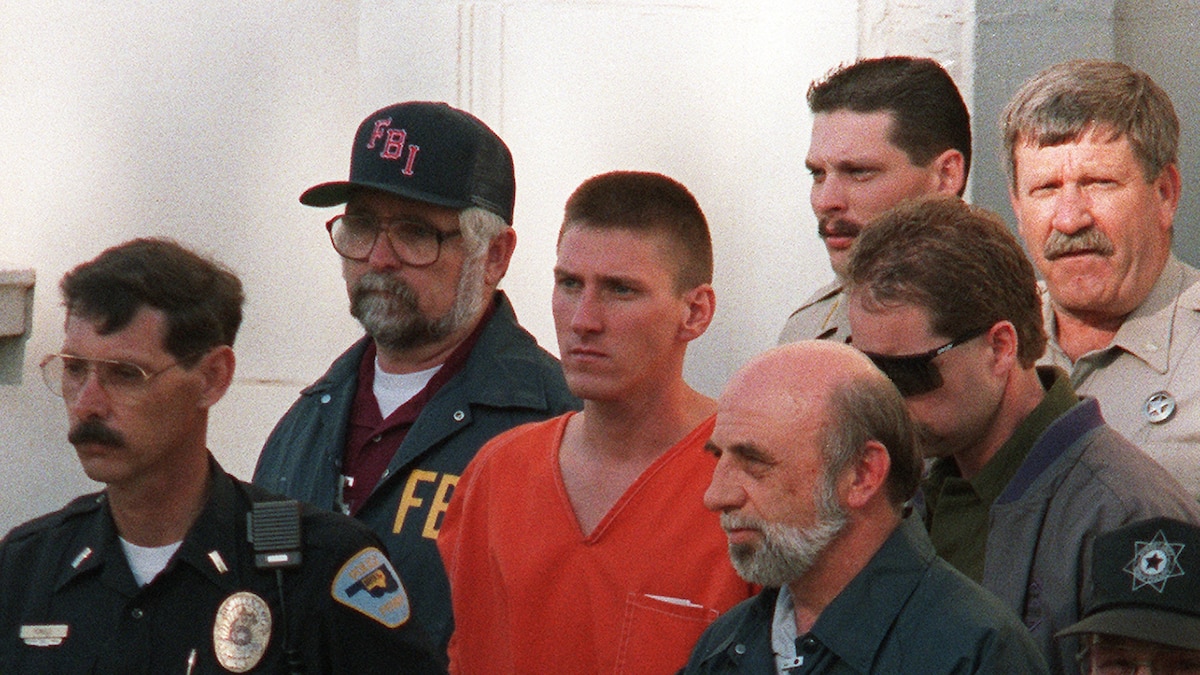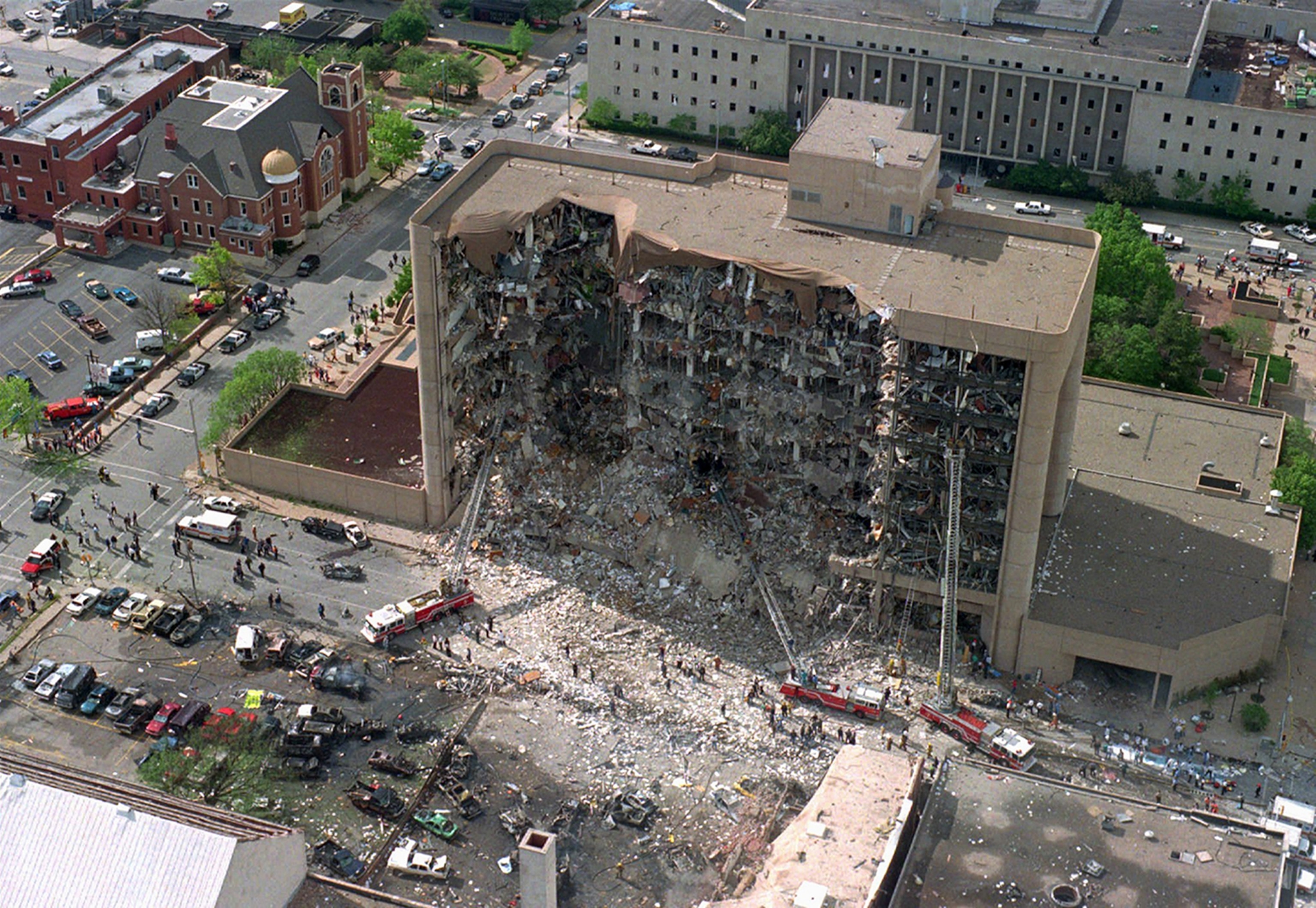Now Reading: How the Oklahoma City bombing forced Americans to confront a hidden threat
-
01
How the Oklahoma City bombing forced Americans to confront a hidden threat
How the Oklahoma City bombing forced Americans to confront a hidden threat

At 9:02 a.m. on April 19, 1995, a bomb ripped open the Alfred P. Murrah Federal Building in Oklahoma City. The explosion took the lives of 168 people, including 19 young children. It would go down as one of the deadliest terrorist attacks in U.S. history.
It also forced Americans to grapple with an uncomfortable truth: that one of the country’s biggest threats was domestic terrorism. The man behind the attack, Timothy McVeigh, wasn’t a foreign agent. He was an Army vet who believed his 168 victims were merely “collateral damage” in his personal war against the federal government.

This photograph shows the north side of the Alfred P. Murrah Federal Building in Oklahoma City after the April 19, 1995, bombing that killed 168 people and injured hundreds. Thirty years later, it remains one of the deadliest terrorist attacks in U.S. history.
Photograph by AP Photo
McVeigh’s attack shocked the country, reawakening Americans to a danger they had largely overlooked: anti-government extremism. In the wake of the bombing, America reaffirmed its commitment to combatting domestic terrorism—before the 9/11 attacks shifted the country’s focus once again.
(How memorials to 9/11 help us remember and mourn.)
Ahead of the bombing’s 30th anniversary, Oklahoma City Bombing: One Day in America, which premieres on National Geographic on April 2 at 8/7c, tells the story of the attack, the people who lived through it, and the ones who didn’t.
Here’s how the Oklahoma City bombing forced Americans to confront the reality of domestic terrorism.
Domestic terrorism under the radar
For decades before the bombing, federal agencies had been focused on violence from left-wing groups like the Weather Underground and the New World Liberation Front. This led to a blind spot on other kinds of domestic threats, including rightwing anti-government extremism. The 1993 bombing of the World Trade Center—the first major foreign terrorist attack on U.S. soil—also focused attention on threats from abroad.
So, when the bomb rocked Oklahoma City that April morning, few imagined that it was an act of domestic terrorism. As the smoke cleared, law enforcement scrambled to find out who was behind the attack—and why they had done it.

Nineteen children were killed in the Oklahoma City bombing—which flattened the daycare center that was on the second floor of the Murrah Building.
Photograph by Robert Daemmrich Photography Inc, Getty Images

The impact of McVeigh’s bomb—which was made out of agricultural fertilizer, diesel fuel, and other chemicals—could be felt as far as 55 miles from the site of the explosion.
Photograph by Robert Daemmrich Photography Inc, Getty Images
Meanwhile, the public leaned on speculation. Without any solid evidence, NBC News reporter Connie Chung reported on air, “A U.S. government source has told CBS News that [the bombing] has Middle Eastern terrorism written all over it.” Other journalists and pundits promoted similar theories on air and in print.
Many in Oklahoma City jumped to the same conclusion. “I thought it was a group of terrorists from the Middle East,” survivor Fran Ferrari recalled. “Was it just Oklahoma City? Was it other cities? It was just anger. I thought, ‘How dare you ever do this, here in the United States.’”
Rumors of a Middle Eastern perpetrator unleashed anti-Muslim hate across the country. In Stillwater, Oklahoma, a man fired a gun at a mosque. No one was injured, but he destroyed some of the building’s windows. Authorities even targeted Muslim Americans, such as when federal agents arrested and detained Abraham Ahmad, a U.S. Citizen, when he returned from a trip abroad the day after the attack.
In this surge of Islamophobia, President Bill Clinton kept a level head. “I remember almost immediately, I said, ‘Everybody’s going to think this is a foreign terrorist incident.’ But I thought it was very important not to make that assumption,” he told One Day in America.
Indeed, when authorities finally identified Timothy McVeigh as the perpetrator, it turned out he wasn’t a foreign asset––he was a homegrown terrorist.
A radicalized American
At first glance, Timothy McVeigh appeared a clean-cut, upstanding citizen. The 26-year-old New York native was a decorated veteran who had served in the Gulf War––but he failed to gain admission to the Army Special Forces, which may have made him resentful toward the government.
By the early 1990s, McVeigh harbored extremist political views and had turned on the federal government, believing that it was oppressive and infringing on Americans’ right to possess guns.
A significant stepping-stone to his radicalization happened in 1993, when the Bureau of Alcohol, Tobacco, Firearms, and Explosives (ATF) raided a cult compound outside of Waco, Texas, where the Branch Davidians had a cache of illegal firearms. The raid led to a 51-day standoff between cult members and federal agents. On April 19, 1993, two years to the day before the attack in Oklahoma City, agents used teargas—which sparked a fire that killed 76 people.
You May Also Like
The incident fueled McVeigh’s anger toward the government. And so, likely using inspiration from The Turner Diaries—a novel which promoted racism and described the truck-bombing of a federal building—McVeigh plotted his attack. In the days leading up to the bombing, he sent letters to his sister, claiming, “something big is going to happen in the month of the bull,” and excerpts from The Turner Diaries.
When McVeigh was caught—officials tracked him down after they located part of the rental truck he had used to carry out the attack—Americans had a hard time digesting the news that the bombing was an act of domestic terrorism.
Broadcast journalist Robin Marsh was reporting from Oklahoma City in the immediate aftermath of the attack. “You never thought this would happen here, never Oklahoma City, never home,” she says. “It might even be harder to accept that it’s an American who did this.”
District fire chief Mike Shannon expressed a similar disbelief. “When we found out that McVeigh was caught, and he was an American… There were a lot of veterans down there. All the firefighters couldn’t believe it.”
The trial and subsequent investigations shed light on McVeigh’s motives and history of anti-government sentiment. Both McVeigh’s sister Jennifer and his friend Michael Fortier testified about the perpetrator’s extremist beliefs in the years leading up to the attack.
Fortier was eventually convicted for transporting stolen weapons, while a third conspirator, Terry Nichols, was sentenced to life imprisonment for planning the attack with McVeigh.
The conviction of McVeigh and his co-conspirators also forced investigators to confront challenging questions. How many would-be domestic terrorists were plotting acts of mass violence? And how could they be stopped?

Although the Oklahoma City bombing may have wakened Americans up to the threat of domestic terrorism, it didn’t last long: On September 11, 2001, the bombing of the World Trade Center in New York City changed the face of terrorism once again.
9/11 changed the face of terrorism—again
Whatever traction authorities gained in the fight against domestic terrorism screeched to a halt on September 11, 2001, when hijackers crashed commercial planes into the World Trade Center and the Pentagon, with another plane bound for D.C. going down in rural Pennsylvania. Al Qaeda, a terrorist organization based in Afghanistan, claimed responsibility—and America’s attention once more shifted to international terrorism.
(Artifacts pulled from the rubble of 9/11 become symbols of what was lost.)
Nonetheless, acts of domestic terrorism accelerated in the 21st century. According to the Center for Strategic and International Studies, there were almost three times as many acts and plots of domestic terrorism between 2018 and 2023 than there had been in all the years from 1994 to 2017. Between September 12, 2001, and December 31, 2016, far-right groups were responsible for 62 extremist incidents in the United States, compared to 23 committed by Islamist extremists. And when a mob attacked Congress on January 6, 2021, FBI director Chris Wray explicitly labeled the incident an act of “domestic terrorism.”
Timothy McVeigh’s politics survived him and continue to be a rallying cry for a new generation of anti-government extremists.
“April 19th, 1995, still matters,” noted Clinton. “It matters a lot because it shows you how wrong things can go and how horrible the consequences can be when someone who feels politically and personally alienated from a country and a government thinks that there’s no sensible alternative to mass violence.
“We need for people to recognize that our differences are good, healthy, even essential. But only if our common humanity matters more. On April the 19th, Timothy McVeigh showed us what happens when our common humanity doesn’t matter anymore.”




















